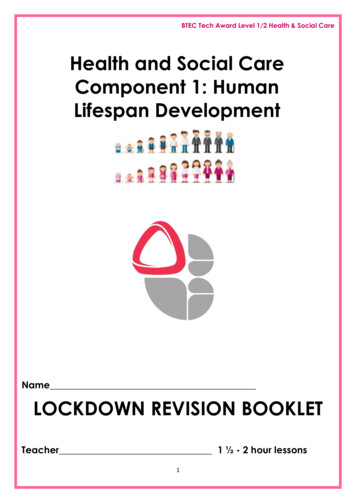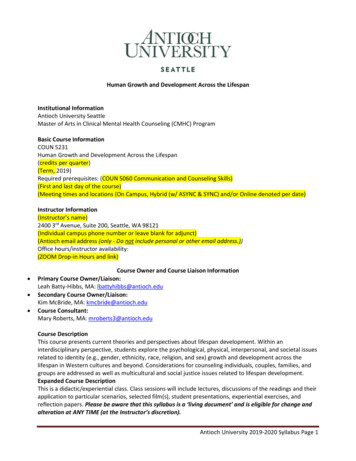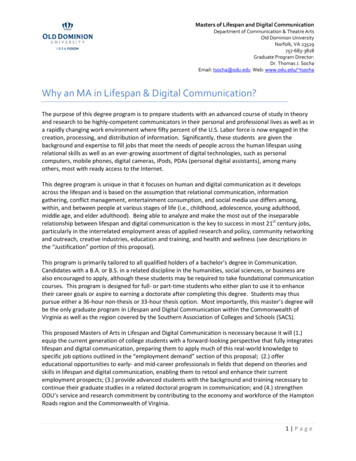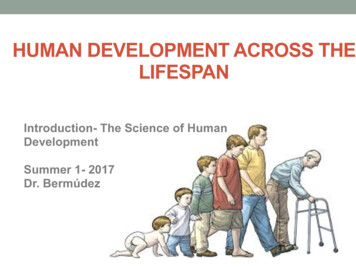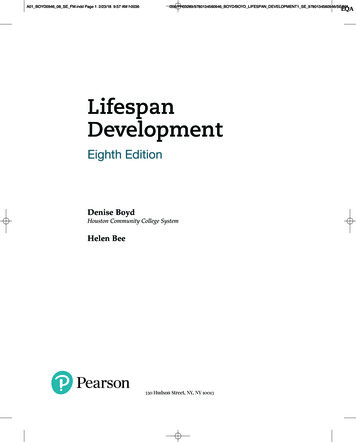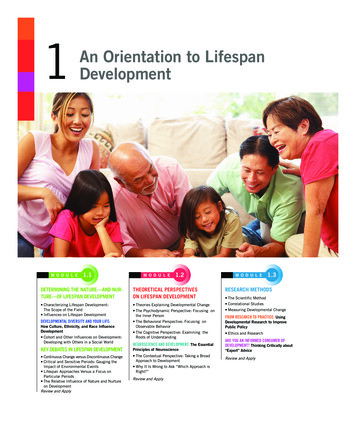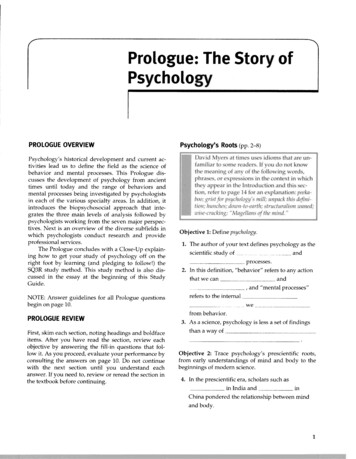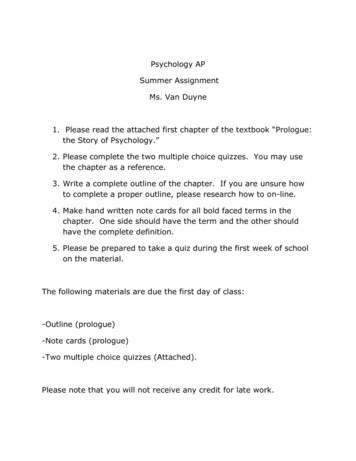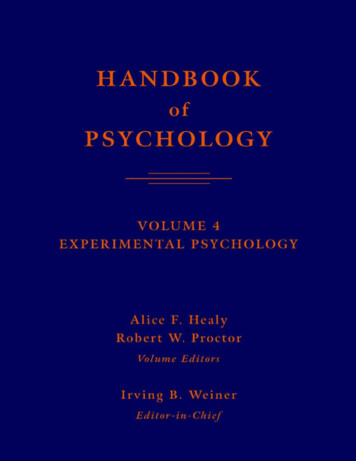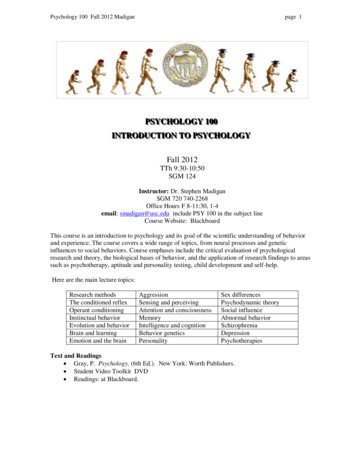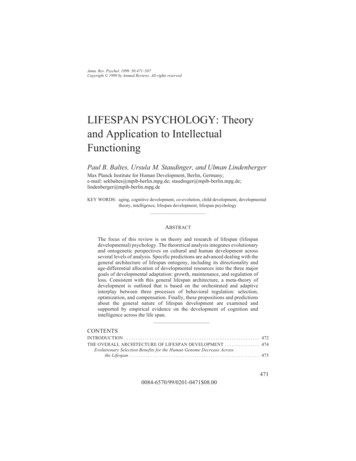
Transcription
Annu. Rev. Psychol. 1999. 50:471–507Copyright 1999 by Annual Reviews. All rights reservedLIFESPAN PSYCHOLOGY: Theoryand Application to IntellectualFunctioningPaul B. Baltes, Ursula M. Staudinger, and Ulman LindenbergerMax Planck Institute for Human Development, Berlin, Germany;e-mail: sekbaltes@mpib-berlin.mpg.de; rlin.mpg.deKEY WORDS: aging, cognitive development, co-evolution, child development, developmentaltheory, intelligence, lifespan development, lifespan psychologyABSTRACTThe focus of this review is on theory and research of lifespan (lifespandevelopmental) psychology. The theoretical analysis integrates evolutionaryand ontogenetic perspectives on cultural and human development acrossseveral levels of analysis. Specific predictions are advanced dealing with thegeneral architecture of lifespan ontogeny, including its directionality andage-differential allocation of developmental resources into the three majorgoals of developmental adaptation: growth, maintenance, and regulation ofloss. Consistent with this general lifespan architecture, a meta-theory ofdevelopment is outlined that is based on the orchestrated and adaptiveinterplay between three processes of behavioral regulation: selection,optimization, and compensation. Finally, these propositions and predictionsabout the general nature of lifespan development are examined andsupported by empirical evidence on the development of cognition andintelligence across the life span.CONTENTSINTRODUCTION . . . . . . . . . . . . . . . . . . . . . . . . . . . . . . . . . . . . . . . . . . . . . . . . . . . . . . . . . . 472THE OVERALL ARCHITECTURE OF LIFESPAN DEVELOPMENT . . . . . . . . . . . . . . . 474Evolutionary Selection Benefits for the Human Genome Decrease Acrossthe Lifespan . . . . . . . . . . . . . . . . . . . . . . . . . . . . . . . . . . . . . . . . . . . . . . . . . . . . . . . . 4750084-6570/99/0201-0471 08.00471
472BALTES, STAUDINGER & LINDENBERGERAge-Related Increase in Need for Culture. . . . . . . . . . . . . . . . . . . . . . . . . . . . . . . . . . . . .Age-Related Decrease in Efficacy of Culture . . . . . . . . . . . . . . . . . . . . . . . . . . . . . . . . . .LIFESPAN CHANGES IN THE RELATIVE ALLOCATION OF RESOURCESTO VARIOUS GOALS OF DEVELOPMENT . . . . . . . . . . . . . . . . . . . . . . . . . . . . . . .METATHEORETICAL AND METHODOLOGICAL PROPOSITIONS WITHINLIFESPAN PSYCHOLOGY . . . . . . . . . . . . . . . . . . . . . . . . . . . . . . . . . . . . . . . . . . . . .Development as Change in Adaptive Capacity . . . . . . . . . . . . . . . . . . . . . . . . . . . . . . . . .Plasticity and Age-Associated Changes. . . . . . . . . . . . . . . . . . . . . . . . . . . . . . . . . . . . . . .Methodological Developments . . . . . . . . . . . . . . . . . . . . . . . . . . . . . . . . . . . . . . . . . . . . . .A SYSTEMIC THEORY OF LIFESPAN DEVELOPMENT: SELECTIVEOPTIMIZATION WITH COMPENSATION . . . . . . . . . . . . . . . . . . . . . . . . . . . . . . . .Definition of Selection, Optimization, and Compensation . . . . . . . . . . . . . . . . . . . . . . . .Selective Optimization with Compensation: Orchestration and Dynamics inDevelopment . . . . . . . . . . . . . . . . . . . . . . . . . . . . . . . . . . . . . . . . . . . . . . . . . . . . . . .THE TWO–COMPONENT MODEL OF LIFESPAN INTELLECTUALDEVELOPMENT . . . . . . . . . . . . . . . . . . . . . . . . . . . . . . . . . . . . . . . . . . . . . . . . . . . . . .The Mechanics of Cognition. . . . . . . . . . . . . . . . . . . . . . . . . . . . . . . . . . . . . . . . . . . . . . . .The Pragmatics of Cognition . . . . . . . . . . . . . . . . . . . . . . . . . . . . . . . . . . . . . . . . . . . . . . .Mechanic/Pragmatic Interdependence . . . . . . . . . . . . . . . . . . . . . . . . . . . . . . . . . . . . . . .Plasticity (Malleability) in Intellectual Functioning Across Historical andOntogenetic Time: Evidence from Adult Development . . . . . . . . . . . . . . . . . . . . . .Relative Stability of Intellectual Functioning Across the Lifespan . . . . . . . . . . . . . . . . .Lifespan Changes in Heritability . . . . . . . . . . . . . . . . . . . . . . . . . . . . . . . . . . . . . . . . . . . .Structural Changes in Intellectual Abilities: The Differentiation/DedifferentiationHypothesis . . . . . . . . . . . . . . . . . . . . . . . . . . . . . . . . . . . . . . . . . . . . . . . . . . . . . . . . .CONCLUSIONS . . . . . . . . . . . . . . . . . . . . . . . . . . . . . . . . . . . . . . . . . . . . . . . . . . . . . . . . . . 98498499INTRODUCTIONLifespan developmental psychology or lifespan psychology (LP) deals withthe study of individual development (ontogenesis) from conception into oldage (PB Baltes et al 1980, Dixon & Lerner 1988, Neugarten 1996, Thomae1979). A core assumption of LP is that development is not completed at adulthood but that it extends across the entire life course and that from conceptiononward lifelong adaptive processes of acquisition, maintenance, transformation, and attrition in psychological structures and functions are involved. Thesimultaneous concern for acquisition, maintenance, transformation, and attrition exemplifies the view of lifespan psychologists that the overall ontogenesisof mind and behavior is dynamic, multidimensional, multifunctional, and nonlinear (PB Baltes 1997).Lifespan research and theory is intended to generate knowledge aboutthree components of individual development: (a) interindividual commonalities (regularities) in development; (b) interindividual differences in development; and (c) intraindividual plasticity (malleability) in development. Joint attention to each of these components and the specification of their age-relatedinterplays are the conceptual and methodological foundations of the develop-
LIFESPAN PSYCHOLOGY473mental enterprise (PB Baltes et al 1988, Nesselroade 1991, Weinert & Perner1996).On a strategic level, there are two ways to construct lifespan theory: personcentered (holistic) and function-centered. The holistic approach (Magnusson1996, Smith & Baltes 1997) proceeds from consideration of the person as asystem and attempts to generate a knowledge base about lifespan developmentby describing and connecting age periods or states of development into oneoverall pattern of lifetime individual development. An example would be Erikson’s (1959) theory of eight lifespan stages. Often, this holistic approach to thelife span is identified with life-course psychology (Bühler 1933; see also Elder1998). The function-centered way to construct lifespan theory is to focus on acategory of behavior or a mechanism (such as perception, information processing, action control, attachment, identity, personality traits, etc.) and to describe the lifespan changes in the mechanisms and processes associated withthe category selected. To incorporate both approaches to lifespan ontogenesisin one conceptual framework, the concept of lifespan developmental psychology (PB Baltes & Goulet 1970) was advanced.Contrary to the American tradition (Parke et al 1991), in Germany JohannNikolaus Tetens (1777) is considered the founder of the field of developmentalpsychology (PB Baltes 1983, Müller-Brettel & Dixon 1990, Reinert 1979).From the beginning, the German conception of developmental psychologycovered the entire life span and, in its emergence, was closely tied to the role ofphilosophy, humanism, and education (Bildung). In contrast, the Zeitgeist inNorth America and some European countries, such as England, was differentwhen developmental psychology emerged as a specialty, around the turn of thetwentieth century. At that time, the newly developed fields of genetics and biological evolution were at the forefront of ontogenetic thinking. From biology,with its maturation-based concept of growth, may have sprung the dominantAmerican emphasis in developmental psychology on child psychology andchild development. As a consequence, in American psychology a strong bifurcation evolved between child developmentalists, adult developmentalists, andgerontologists.In recent decades, however, a lifespan approach has become more prominent in North America because of several factors. First was a concern with lifespan development in neighboring social-science disciplines, especially sociology. Life-course sociology took hold as a powerful intellectual force (Elder1998, Featherman 1983, Mayer 1990, Riley 1987). A second factor was theemergence of gerontology as a field of specialization, with its search for thelife-long precursors of aging (Birren & Schaie 1996, Neugarten 1996). A thirdfactor, and a source of rapprochement between child developmentalists andadult developmentalists, was the aging of several classic longitudinal studieson child development begun in the 1920s and 1930s. In the wake of these de-
474BALTES, STAUDINGER & LINDENBERGERvelopments, the need for better collaboration among all age specialties of developmental scholarship has become an imperative of current-day research indevelopmental psychology (Cairns 1998, Hetherington et al 1988, Rutter &Rutter 1993). But for good lifespan theory to evolve, it takes more than courtship and mutual recognition. It takes a new effort and serious exploration oftheory that—in the tradition of Tetens (1777)—has as its primary substantivefocus the structure, sequence, and dynamics of the entire life course in a changing society.THE OVERALL ARCHITECTURE OF LIFESPANDEVELOPMENTWe approach psychological theories of LP proceeding from the distal and general to the more proximal and specific. The first level of analysis is the overallbiological and cultural architecture of lifespan development (PB Baltes 1997,PB Baltes et al 1998). As shown in Figure 1, the benefits of evolutionary selection decrease with age, the need for culture increases with age, and the efficacyof culture decreases with age. The specific form (level, shape) of the functionsshowing the overall dynamics between biology and culture across the life spanis not critical. What is critical is the overall direction and the reciprocal relationship between these functions.Evolutionary SelectionBenefits: Decrease with AgeNeed for Culture:Increases with AgeEfficacy of Culture:Decreases with AgeLife SpanLife SpanLife SpanFigure 1 Schematic representation of the average dynamics between biology and culture acrossthe life span (after PB Baltes 1997). There can be much debate about the specific forms of thefunctions, but less about their direction.
LIFESPAN PSYCHOLOGY475Evolutionary Selection Benefits for the Human GenomeDecrease Across the LifespanThe first component of the tri-partite argument derives from an evolutionaryperspective on the nature of the genome and its age-correlated changes in expressivity and biological potential (Finch 1996, Jazwinski 1996, Martin et al1996): During evolution, the older the organism, the less the genome benefitedfrom the genetic advantages associated with evolutionary selection. In otherwords, the benefits resulting from evolutionary selection display a negativeage correlation. Certainly after maturity, and with age, the expressions andmechanisms of the genome lose in functional quality.This assertion is in line with the idea that evolutionary selection was tied tothe process of reproductive fitness and its location in the first half of the lifecourse. This general statement holds true even though indirect positive evolutionary selection benefits are carried into old age, for instance, through grandparenting (Mergler & Goldstein 1983), coupling, or exaptation (Gould 1984).This age-associated diminution of evolutionary selection benefits and itsimplied association with an age-related loss of biological potential was further affected by the fact that in earlier times few people reached old age. Thus,in addition to the negative correlation between age and selection pressure,most people died before possible negative genetic attributes were activated orpossible negative biological effects of earlier developmental events becamemanifest. The relative neglect during evolution of the second half of life is amplified further by other aspects of the biology of aging. For all living systems,there are costs involved in creating and maintaining life (Finch 1996, Jazwinski 1996, Martin et al 1996, Yates & Benton 1995). For instance, biological aging involves wear-and-tear as well as the cumulation of errors in genetic replication and repair.Age-Related Increase in Need for CultureThe middle part of Figure 1 summarizes the overall perspective on lifespan development associated with culture and culture-based processes. By culture, wemean all the psychological, social, material, and symbolic (knowledge-based)resources that humans have produced over the millennia. These, as they aretransmitted across generations in increasing quantity and quality, make possible human development as we know it (Cole 1996, Durham 1991, Valsiner &Lawrence 1997). Among these cultural resources are cognitive skills, motivational dispositions, socialization strategies, literacy, written documents, physical structures, and the world of economics as well that of medical and physicaltechnology.The argument for an age-related increase in the “need” for culture has twoparts. First, for human ontogenesis to have reached higher and higher levels of
476BALTES, STAUDINGER & LINDENBERGERfunctioning, whether in physical or psychological domains, there had to be aconjoint evolutionary increase in the richness and dissemination of the resourcesand “opportunities” of culture (Durham 1991, Valsiner & Lawrence 1997). Thefarther we expect human ontogenesis to extend itself into adult life and old age,the more necessary it will be for particular cultural factors and resources toemerge to make this possible. Consider, for instance, what happened to averagelife expectancy and educational status (such as reading and writing skills) inindustrialized countries during the twentieth century. The genetic make-up ofthe population did not change during this time. It is primarily through the medium of more advanced levels of culture including technology that people havehad the opportunity to continue to develop throughout longer spans of life.The second argument for the proposition relates to the biological weakening associated with age. That is, the older we are, the more we need culturebased resources (material, social, economic, psychological) to generate andmaintain high levels of functioning. A case in point is that for cognitive efficacy to continue into old age at comparable levels of performance, more cognitive support and training are necessary (PB Baltes & Kliegl 1992, Dixon &Bäckman 1995, Hoyer & Rybash 1994, Salthouse 1991).Age-Related Decrease in Efficacy of CultureThe third cornerstone of the overall nature of lifespan development is the lifespan script of a decreasing efficacy of cultural factors and resources. Duringthe second half of life, and despite the advantages associated with the developmental acquisition of knowledge-based mental representations (Klix 1993),there is an age-associated reduction in the efficiency of cultural factors, eventhough large interindividual and interdomain differences exist in onset andrate of these losses in efficiency (Hoyer & Rybash 1994, Lindenberger & Baltes 1997, Nelson & Dannefer 1992, Salthouse 1991, Schaie 1996). The olderthe adult, the more time and practice it takes to attain the same learning gains.Moreover, at least in some domains of information processing, and when itcomes to high levels of performance, older adults may not be able to reach thesame levels of functioning as younger adults, even after extensive training andunder positive life circumstances (PB Baltes 1997, PB Baltes & Smith 1997,Kliegl et al 1989).There are two causes for this age-related reduction in cultural efficacy or efficiency. The first is age-related loss in biological potential. The second can beseen by viewing the life course in analogy to a learning curve and the acquisition of expertise (Ericsson & Lehmann 1996). Similar to reduced gains in laterphases of learning, more and more effort and better technology are necessaryto produce further advances as during development we reach higher levels offunctioning. Moreover, there is the possibility of age-related increases in negative transfer and costs of specialized knowledge.
LIFESPAN PSYCHOLOGY477The age-related reduction in cultural efficacy argument is likely to raise objection in some social-science circles (PB Baltes et al 1998, Cole 1996, Lerner1998a). One objection would be that the specifics of cultural systems, namelyits symbolic-representational form, may follow different mechanisms of efficiency. For instance, the lifespan developmental entropy costs of symbolicsystems may be less than those observed for basic biological processes. A second objection would be that the concept of efficiency contains assumptionsabout human functioning which are inherently opposed to phenomena such asmeaning of life, a sense of religion, or an understanding of one’s finitude.However, such perspectives, important and critical as they are to understanding human development, do not alter the general direction of the lifespan function outlined.Together, the three conditions and trajectories outlined in Figure 1 form arobust and interrelated fabric (architecture) of the lifespan dynamics betweenbiology and culture. This fabric represents a first tier of lifespan theory (PBBaltes 1997). For evolutionary and historical reasons, the ontogenetic structure of the life course displays a kind of unfinished architecture. Whatever thespecific content and form of a given psychological theory of lifespan development, it needs to be consistent with the framework outlined.LIFESPAN CHANGES IN THE RELATIVE ALLOCATIONOF RESOURCES TO VARIOUS GOALS OFDEVELOPMENTTo what degree does the overall architecture of age-related dynamics betweenbiology and culture outlined here prefigure pathways of development and thekind of adaptive challenges that we face as we move through life? One way tounderstand some of the consequences is to distinguish between three goals ofontogenetic development: growth, maintenance (including resilience), and theregulation of loss. The allocation of available resources for growth, the first ofthese major adaptive tasks, decreases with age, whereas investments into thelatter, maintenance and regulation of loss, increase with age (PB Baltes et al1998, Staudinger et al 1995).By growth, we mean behaviors aimed at reaching higher levels of functioning or adaptive capacity. Under the heading of maintenance, we group behaviors aimed either at maintaining levels of functioning in the face of a new challenge or at returning to previous levels after a loss. With the adaptive task ofregulation of loss, we identify behaviors that organize adequate functioning atlower levels when maintenance or recovery—for instance because of externalor internal losses in resources—is no longer possible.In our view, the lifespan shift in the relative allocation of resources, awayfrom growth towards the goals of maintenance and the regulation of loss, is a
478BALTES, STAUDINGER & LINDENBERGERcritical issue for any theory of lifespan development (for related arguments,see also Brandtstädter & Greve 1994, Brim 1992, Uttal & Perlmutter 1989).This is true even for those theories that, on the surface, seem to focus only ongrowth or positive aging (e.g. Erikson 1959, Labouvie-Vief 1995, McAdams& de St. Aubin 1998, Perlmutter 1988, Staudinger 1996). In Erikson’s theory,for instance, acquiring generativity and wisdom is the positive developmentalgoal of adulthood. Despite the growth orientation of these constructs, their attainment is inherently tied to recognizing and managing generational turnoveras well as managing or becoming reconciled to one’s functional losses, finitude, and impending death.The dynamics between the lifespan trajectories of growth, maintenance,and regulation should also be emphasized. The mastery of life often involvesconflicts and competition among the three goals of human development. Consider, for example, the interplay between autonomy and dependence in children and older adults (MM Baltes 1996, MM Baltes & Silverberg 1994).Whereas the primary focus of the first half of life is the maximization of independence and autonomy, the goal-profile changes in old age. The productiveand creative use of dependence rather than independence becomes critical. Byinvoking dependence and support, older people free up resources for use inother domains involving personal efficacy and growth.The age-related weakening of the biological foundation and the change inthe overall lifespan script associated with growth, maintenance, and regulationof loss does not imply that there is no opportunity for growth at all in the second half of life in some domains. Deficits in biological status can also be thefoundation for progress, that is, antecedents for positive changes in adaptivecapacity. The most radical view of this proposition is contained in the notion of“culture as compensation.” Under the influence of cultural-anthropological aswell as evolutionary biological arguments, researchers have recognized thatsuboptimal biological states or imperfections are catalysts for the evolution ofculture and for advanced states achieved in human ontogeny (PB Baltes 1997,Klix 1993, Magnusson 1996, Uttal & Perlmutter 1989). In this line of thinking,the human organism is by nature (Gehlen 1956) a “being of deficits” (Mängelwesen) and social culture has developed or emerged in part to deal specificallywith biological deficits.This “deficits-breed-growth” mechanism may not only account forcultural-biological evolution, it may also affect ontogenesis. Thus it is possiblethat when people reach states of increased vulnerability in old age, socialforces and individuals invest more and more heavily in efforts that are explicitly oriented toward regulating and compensating for age-associated biologicaldeficits, thereby generating a broad range of novel behaviors, new bodies ofknowledge and values, new environmental features, and, as a result, a higherlevel of adaptive capacity. Emerging research on psychological compensation
LIFESPAN PSYCHOLOGY479is a powerful illustration of the idea that deficits can be catalysts for positivechanges in adaptive capacity (MM Baltes 1996, PB Baltes & Baltes 1990,Brandtstädter 1998, Dixon & Bäckman 1995, Marsiske et al 1995)METATHEORETICAL AND METHODOLOGICALPROPOSITIONS WITHIN LIFESPAN PSYCHOLOGYDevelopment as Change in Adaptive CapacityFrom a lifespan theory point of view, it is important to articulate concepts ofdevelopment that go beyond linear, unidimensional, unidirectional, and unifunctional models, which had flourished in conjunction with the traditionalbiological conceptions of growth or physical maturation. In these traditionalconceptions of development, attributes such as qualitative change, ordered sequentiality, irreversibility, and the definition of an end state were critical.In their conceptual work, lifespan developmentalists attempted either to modulate the traditional definitional approach to development or to offer alternative conceptionsof ontogenetic development that departed from the notion of holistic and unidirectional growth, according to which all aspects of the developing systemwere geared toward a higher level of integration and functioning. LabouvieVief (1982, 1992), for instance, introduced new forms (stages) of systemicfunctioning for the period of adulthood, based on conceptions of developmentas adaptive transformation and structural reorganization, thereby opening anew vista on neo-Piagetian constructivism.Baltes and his colleagues (e.g. PB Baltes 1997, PB Baltes et al 1980, 1998)were more radical in their departure from extant theoretical models of development. Considering evolutionary perspectives (PB Baltes 1987, Magnusson1996), neofunctionalism (Dixon & Baltes 1986), and lifespan contextualism(Lerner 1991), they opted for a more flexible construction of development.One such model was to define development as selective age-related change inadaptive capacity. With the focus on selection and selective adaptation, lifespan researchers were able to be more open about the pathways of life-long ontogenesis. For instance, with this neofunctionalist approach, it becomes possible to treat the developing system as multidimensional, multifunctional, anddynamic, in which differing domains and functions develop in a less than fullyintegrated manner, and where trade-offs between functional advances and discontinuities between age levels are the rule rather than the exception (see alsoBrim & Kagan 1980, Labouvie-Vief 1982, Siegler 1997, Thelen & Smith1998).DEVELOPMENT AS SELECTION AND SELECTIVE ADAPTATIONDEVELOPMENT AS A GAIN-LOSS DYNAMIC A related change in emphasisadvanced in lifespan theory and research was to view development as always
480BALTES, STAUDINGER & LINDENBERGERbeing constituted by gains and losses (PB Baltes 1987, PB Baltes et al 1980,1998, Brandtstädter 1998, Labouvie-Vief 1982). Aside from functionalist arguments, several empirical findings gave rise to this focus.One example important to lifespan researchers was the differing lifespantrajectories proposed and observed for various components of intelligence(Cattell 1971, Horn & Hofer 1992, Schaie 1994, 1996). For intelligence,throughout the life span gains and losses co-exist. In addition, the open systems view of the incomplete biological and cultural architecture of lifespandevelopment and the multiple ecologies of life made it obvious that postulating a single end state to development was inappropriate. Moreover, when considering the complex and changing nature of the criteria involved in everydayadaptation (which, for instance, across ages differ widely in the characteristicsof task demands and outcome criteria; e.g. Berg 1996), the capacity to movebetween levels of knowledge and skills rather than to operate at one specificdevelopmental level of functioning appeared crucial for effective individualdevelopment. Furthermore, the dynamics between gains and losses were highlighted by the phenomenon of negative transfer associated with the evolutionof any form of specialization or expertise (Ericsson & Lehmann 1996). As aresult, a monolithic view of development as universal growth was rejected astheoretically false and empirically inappropriate.Recently, one additional concept has been advanced to characterize thenature of lifespan changes in adaptive capacity. This concept is equifinality:As a special case of multifunctionality, the same developmental outcome canbe reached by different means and combination of means (Kruglanski 1996,Ribaupierre 1995). The role of equifinality is perhaps most evident in the different ways by which individuals reach an identical level of subjective wellbeing (Brandtstädter & Greve 1994, Heckhausen & Brim 1997, Smith & Baltes 1997, Staudinger et al 1995). The potential for developmental impact islarger if the resources acquired during ontogenesis carry, in the sense of equifinality and multifunctionality, much potential for generalization and adaptiveuse in rather different contexts.Plasticity and Age-Associated ChangesThe strong concern of lifespan researchers with intraindividual plasticity(malleability) highlights the search for the potentialities of development, including its upper and lower boundary conditions. Implied in the idea of plasticity is that any given developmental outcome is but one of numerous possibleoutcomes, and that the search for the conditions and range of ontogenetic plasticity, including its age-associated changes, is fundamental to the study of development.As lifespan psychologists initiated systematic work on the concept of plasticity, further differentiation of it was introduced. One involved the differen-
LIFESPAN PSYCHOLOGY481tiation between baseline reserve capacity and developmental reserve capacity(PB Baltes 1987, Kliegl et al 1989). Baseline reserve capacity identifies thecurrent level of plasticity available to individuals. Developmental reserve capacity is aimed at specifying what is possible in principle over developmentaltime if optimizing interventions are employed to estimate future ontogeneticpotential. Furthermore, major efforts were made to specify the kind of methodologies that lend themselves to a full exploration of age-related changes inplasticity and its limits (Kruse et al 1993, Lindenberger & Baltes 1995).Methodological DevelopmentsMetatheory and methodology have been closely intertwined since the veryearly origins of LP (e.g. Quetelet 1842). Not surprisingly, therefore, the searchfor methods adequate for the study of developmental processes is a continuingpart of the agenda of lifespan researchers (Cohen & Reese 1994, Hertzog 1996,Lindenberger & Baltes 1995, Lindenberger & Pötter 1998, Magnusson 1996,Nesselroade & Thompson 1995).One methodological development concerns methods to organize and study the temporal flow, correlates,and consequences of life events. Life-course sociologists, in particular, havemade major contributions to the advancement of this methodology. Among therelevant methods, models of event-history analysis and associated methodssuch as hazard rate and survival analysis are especially important (Blossfeld &Rohwer 1995, Willett & Singer 1991).One of the critical events for lifespan researchers is mortality or death. Aslife unfolds from birth into old age, the population itself changes in composition as a result of migration and especially mortality. In advanced old age, forinstance, the surviving age cohort becomes smaller and smaller until it reacheszero. Understanding the intricacies of selective survival and its impact on thenature of ontogenetic fu
span development in neighboring social-science disciplines, especially sociol-ogy. Life-course sociology took hold as a powerful intellectual force (Elder 1998, Featherman 1983, Mayer 1990, Riley 198
